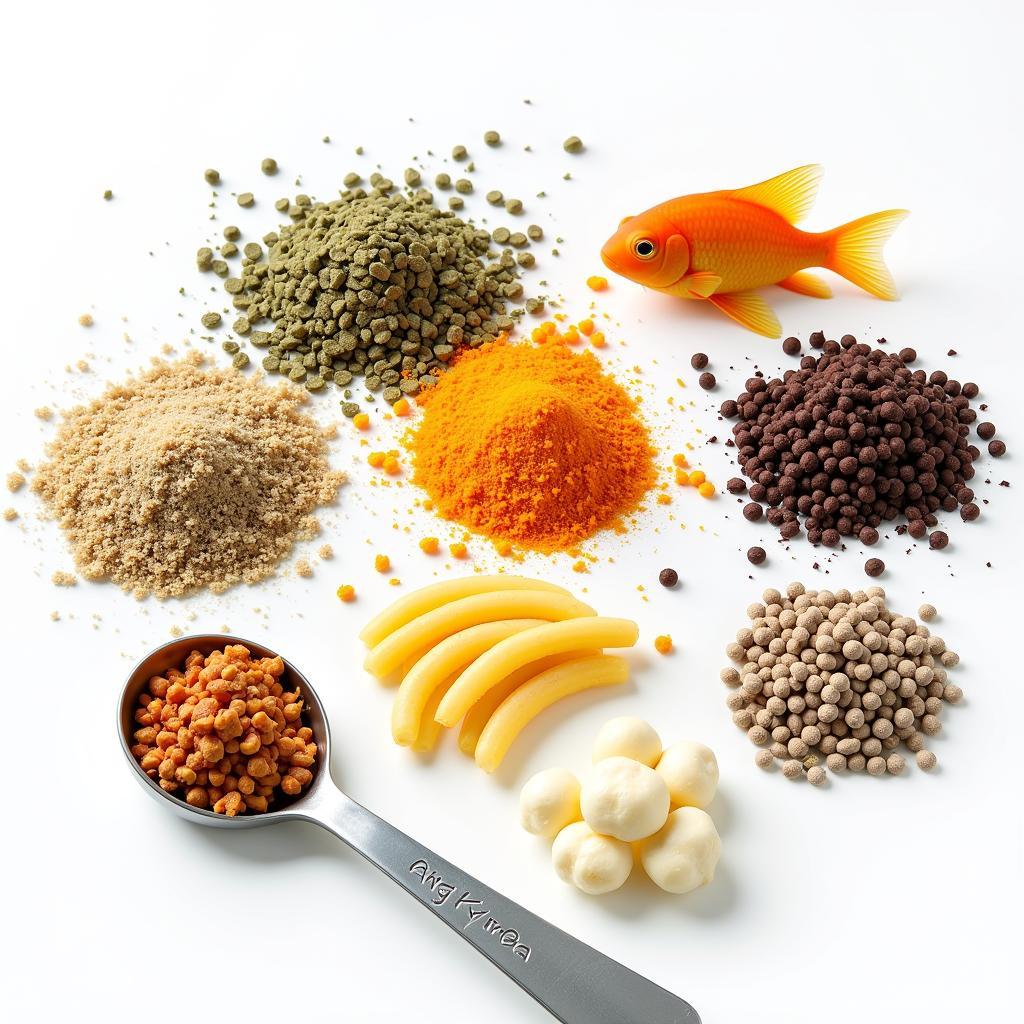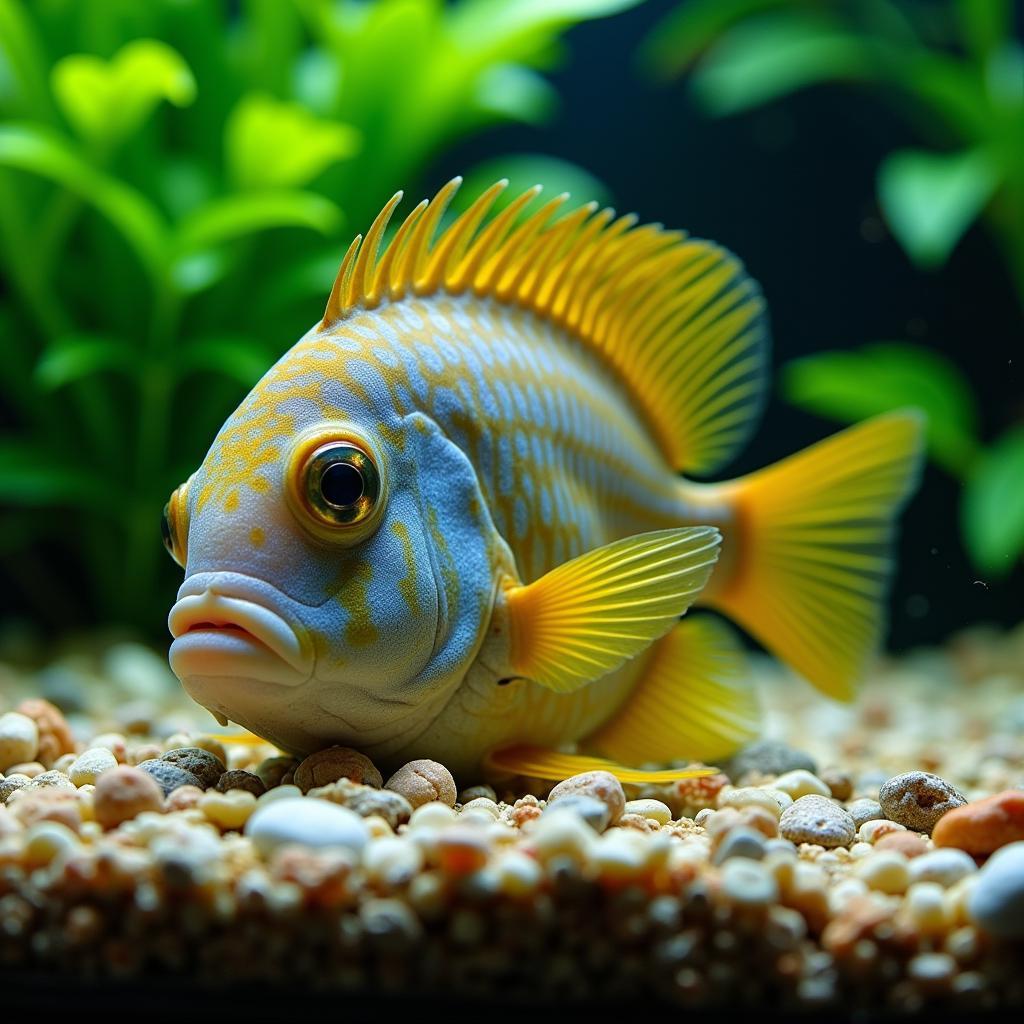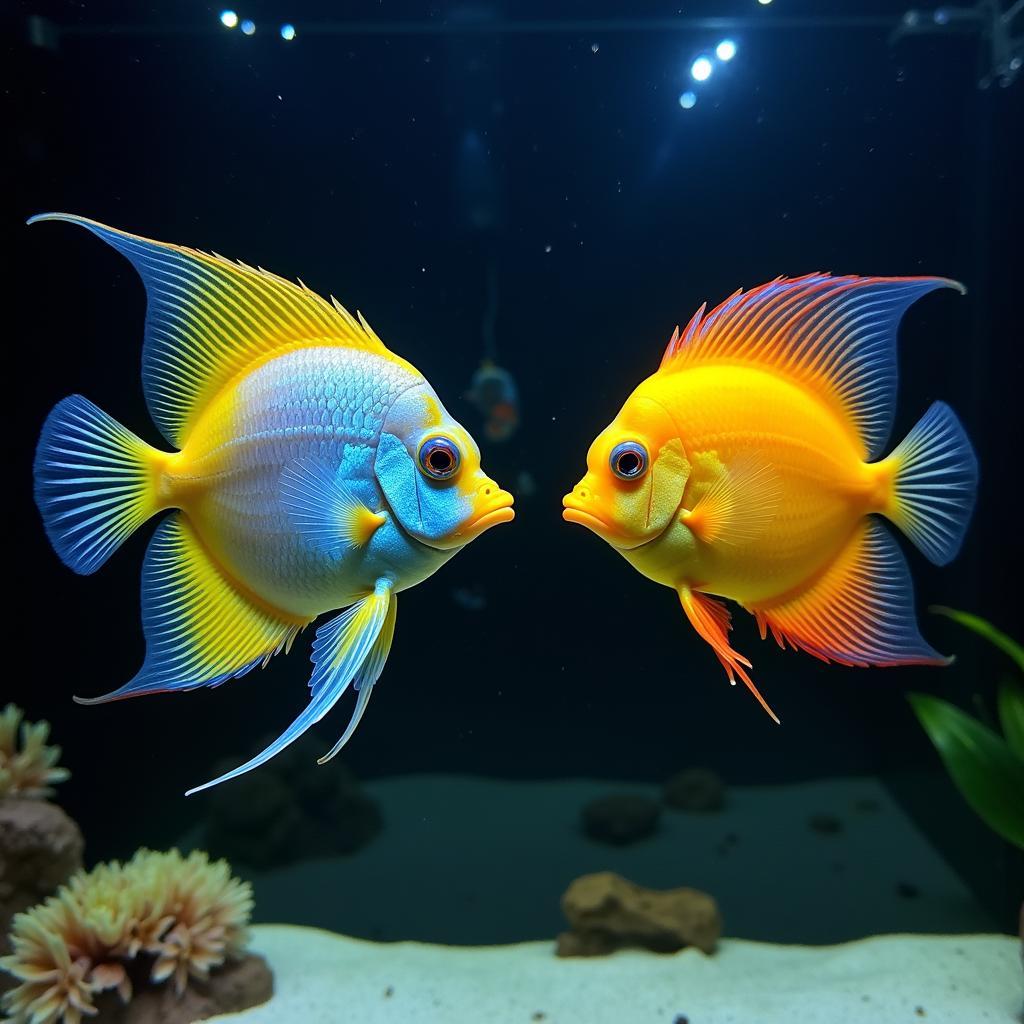Choosing the Best Angelfish Food is crucial for the health, vibrancy, and overall happiness of your aquatic companions. Just like us, angelfish thrive on a varied, nutrient-rich diet. But with so many options available, finding the perfect angelfish food can feel overwhelming. This comprehensive guide dives deep into the world of angelfish nutrition, helping you make informed choices to keep your finned friends healthy and flourishing.
 A variety of angelfish food options including flakes, pellets, and live food
A variety of angelfish food options including flakes, pellets, and live food
Understanding Your Angelfish’s Dietary Needs
Angelfish are omnivores, meaning they need a balanced diet of both meat-based and plant-based foods. In the wild, they feast on a diverse menu of insects, larvae, small crustaceans, algae, and plant matter.
To replicate this varied diet in your aquarium, opt for high-quality angelfish food that includes a mix of the following:
- Protein: Essential for growth, development, and maintaining healthy fins and scales. Look for foods with fish meal, shrimp meal, or insect protein as primary ingredients.
- Fats: Provide energy and support vital bodily functions. Choose foods with healthy fats like omega-3 fatty acids, which are essential for optimal health.
- Fiber: Promotes healthy digestion and prevents constipation. Plant-based ingredients like spirulina and algae provide valuable fiber.
- Vitamins & Minerals: Crucial for boosting the immune system, maintaining strong bones, and enhancing coloration. Look for foods fortified with essential vitamins like A, C, and D, as well as minerals like calcium and phosphorus.
 An angelfish eating from the bottom of a well-planted aquarium
An angelfish eating from the bottom of a well-planted aquarium
Types of Angelfish Food
The best angelfish food comes in various forms, each with its own set of pros and cons.
Flakes
- Pros: Affordable, widely available, and easily eaten by angelfish of all sizes.
- Cons: Can quickly foul the water if not eaten promptly, leading to cloudy water and potential health issues.
Pellets
- Pros: More nutrient-dense than flakes, sink slowly, allowing for better nutrient absorption. Available in various sizes for different angelfish life stages.
- Cons: Can be more expensive than flakes, some angelfish may be hesitant to try pellets at first.
Pro Tip: Opt for tropical fish food pellets that are slow-sinking, allowing your angelfish ample time to consume them before they reach the bottom of the tank.
Live Foods
- Pros: Highly palatable and provide a rich source of protein and other essential nutrients. Stimulate natural foraging instincts.
- Cons: Can introduce parasites or diseases into the aquarium if not sourced from a reputable supplier. Not suitable for all aquarists due to the potential for mess and ethical concerns.
Popular live food options include:
- Brine shrimp
- Bloodworms
- Daphnia
Frozen Foods
- Pros: Convenient alternative to live foods, offer similar nutritional benefits, and have a lower risk of introducing parasites.
- Cons: Require thawing before feeding, can be messier than flakes or pellets.
Freeze-Dried Foods
- Pros: Longer shelf life than live or frozen foods, require no thawing, and retain most of their nutritional value.
- Cons: Can be less palatable than live or frozen options.
Choosing the Right Angelfish Food
When selecting the best angelfish food, consider the following factors:
- Age and Size: Juvenile angelfish require a higher protein intake for growth and development. Opt for foods specifically formulated for young fish. As they mature, their diet should transition to adult formulations.
- Species: While most angelfish share similar dietary needs, certain species may have specific requirements. Research your particular species to determine the optimal diet.
- Health Status: If your angelfish is recovering from illness or experiencing health issues, consult a veterinarian for specific dietary recommendations.
How Often to Feed Angelfish
Angelfish are prone to overeating, so it’s crucial to establish a consistent feeding schedule and avoid overfeeding. Here’s a general guideline:
- Adult Angelfish: Feed once or twice daily, offering only what they can consume within 2-3 minutes.
- Juvenile Angelfish: Feed 2-3 times daily with the same portion control guidelines.
Pro Tip: It’s a good practice to fast your angelfish once a week. This mimics their natural feeding patterns and can aid in digestion.
 Two angelfish, one with vibrant colors and one with duller colors, swimming in an aquarium
Two angelfish, one with vibrant colors and one with duller colors, swimming in an aquarium
Signs of a Healthy Diet
A healthy diet is reflected in your angelfish’s overall appearance and behavior. Look for the following signs:
- Bright, Vibrant Colors: A balanced diet rich in vitamins and minerals enhances the natural coloration of your angelfish.
- Active and Energetic: Well-nourished angelfish are active swimmers and display a healthy appetite.
- Clear Eyes and Smooth Scales: These indicate good overall health and a properly functioning immune system.
- Healthy Fin Growth and Shape: Essential fatty acids in their diet support healthy fin development and prevent fin rot.
Mina Cones Food: Your Trusted Source for Angelfish Nutrition
At Mina Cones Food, we’re passionate about providing the highest quality, nutritionally complete Purina tropical fish food to help your aquatic companions thrive. We carefully curate a diverse selection of angelfish food, catering to their unique dietary needs.
Whether you’re seeking premium flakes, nutrient-packed pellets, or enriching live foods, we have the perfect options to keep your angelfish healthy, vibrant, and full of life. Explore our wide range of products and give your angelfish the gift of optimal nutrition.
Frequently Asked Questions About Best Angelfish Food
1. What is the absolute best food for angelfish?
The best food for your angelfish will depend on their age, species, and individual preferences. However, a high-quality pellet formulated for angelfish, combined with occasional treats of live or frozen foods, is an excellent starting point.
2. Can angelfish eat goldfish flakes?
While goldfish flakes may not be harmful in small amounts, they are not nutritionally complete for angelfish. Goldfish flakes lack certain nutrients that angelfish require, so it’s best to stick with foods specifically formulated for them.
3. How long can angelfish go without food?
Adult angelfish can generally survive for 1-2 weeks without food, while juveniles can last for about a week. However, it’s crucial to avoid depriving them of food for extended periods as it can negatively impact their health.
4. What can I feed my angelfish besides fish food?
Alongside commercially prepared angelfish food, you can offer occasional treats of blanched vegetables like zucchini, spinach, or peas. Ensure to remove any uneaten portions promptly to maintain water quality.
5. Can I feed my angelfish human food?
It’s generally not recommended to feed your angelfish human food. Many human foods lack the essential nutrients they need and can contain additives or seasonings that may be harmful to their health.
6. How can I tell if my angelfish is overweight?
Overweight angelfish may exhibit a swollen belly, lethargy, and difficulty swimming. If you suspect your angelfish is overweight, reduce their food intake and consult a veterinarian for guidance.
7. My angelfish won’t eat pellets, what should I do?
Angelfish can be picky eaters. If they’re refusing pellets, try soaking them in aquarium water for a few minutes to soften them before feeding. You can also try offering a small amount of live or frozen food alongside the pellets to entice them.
Need More Help?
Have other questions about the best angelfish food or caring for your aquatic friends? Visit our website for more informative articles or contact our team of experts at 02437655121, [email protected]. We’re here to help you create a thriving aquatic environment for your angelfish! Or visit us at 3PGH+8R9, ĐT70A, thôn Trung, Bắc Từ Liêm, Hà Nội, Việt Nam. Our customer support team is available 24/7.